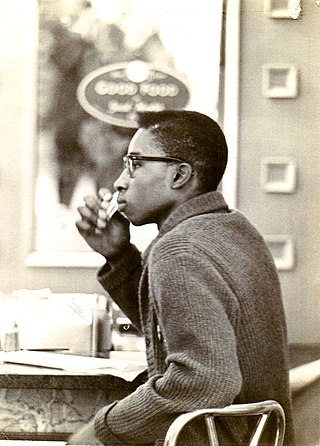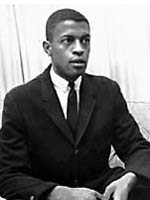Related Research Articles

A sit-in or sit-down is a form of direct action that involves one or more people occupying an area for a protest, often to promote political, social, or economic change. The protestors gather conspicuously in a space or building, refusing to move unless their demands are met. The often clearly visible demonstrations are intended to spread awareness among the public, or disrupt the goings-on of the protested organisation. Lunch counter sit-ins were a nonviolent form of protest used to oppose segregation during the civil rights movement, and often provoked heckling and violence from those opposed to their message.
Thalhimers was a department store chain in the Southern United States. Based in Richmond, Virginia, the chain at its peak operated dozens of stores in Virginia, North Carolina, South Carolina, and one store in Memphis, Tennessee. Thalhimer's traditions were most notable during the holiday season with visits from the sticker-distributing Snow Bear and, in later years, the arrival of Lego Land at the downtown Richmond store.

The Greensboro sit-ins were a series of nonviolent protests in February to July 1960, primarily in the Woolworth store—now the International Civil Rights Center and Museum—in Greensboro, North Carolina, which led to the F. W. Woolworth Company department store chain removing its policy of racial segregation in the Southern United States. While not the first sit-in of the civil rights movement, the Greensboro sit-ins were an instrumental action, and also the best-known sit-ins of the civil rights movement. They are considered a catalyst to the subsequent sit-in movement, in which 70,000 people participated. This sit-in was a contributing factor in the formation of the Student Nonviolent Coordinating Committee (SNCC).

The Nashville sit-ins, which lasted from February 13 to May 10, 1960, were part of a protest to end racial segregation at lunch counters in downtown Nashville, Tennessee. The sit-in campaign, coordinated by the Nashville Student Movement and the Nashville Christian Leadership Council, was notable for its early success and its emphasis on disciplined nonviolence. It was part of a broader sit-in movement that spread across the southern United States in the wake of the Greensboro sit-ins in North Carolina.
The Friendship Nine, or Rock Hill Nine, was a group of African-American men who went to jail after staging a sit-in at a segregated McCrory's lunch counter in Rock Hill, South Carolina in 1961. The group gained nationwide attention because they followed the 1960 Nashville sit-ins strategy of "Jail, No Bail", which lessened the huge financial burden civil rights groups were facing as the sit-in movement spread across the South. They became known as the Friendship Nine because eight of the nine men were students at Rock Hill's Friendship Junior College.
Cain-Sloan Co. Inc. was a department store chain based in Nashville, Tennessee, United States. It was founded in 1903, merged with Allied Stores in 1955, and with Dillard's in 1987. It was a target of the 1960 Nashville sit-ins.
Jibreel Khazan is a civil rights activist who is best known as a member of the Greensboro Four, a group of African American college students who, on February 1, 1960, sat down at a segregated Woolworth's lunch counter in downtown Greensboro, North Carolina challenging the store's policy of denying service to non-white customers. The protests and the subsequent events were major milestones in the Civil Rights Movement.

Clarence Lee "Curly" Harris was the store manager at the F. W. Woolworth Company store in Greensboro, North Carolina, during the Greensboro sit-ins in 1960.

Clara Shepard Luper was a civic leader, schoolteacher, and pioneering leader in the American Civil Rights Movement. She is best known for her leadership role in the 1958 Oklahoma City sit-in movement, as she, her young son and daughter, and numerous young members of the NAACP Youth Council successfully conducted carefully planned nonviolent sit-in protests of downtown drugstore lunch-counters, which overturned their policies of segregation. The success of this sit-in would result in Luper becoming a leader of various sit-ins throughout Oklahoma City between 1958 and 1964. The Clara Luper Corridor is a streetscape and civic beautification project from the Oklahoma Capitol area east to northeast Oklahoma City. In 1972, Clara Luper was an Oklahoma candidate for election to the United States Senate. When asked by the press if she, a black woman, could represent white people, she responded: “Of course, I can represent white people, black people, red people, yellow people, brown people, and polka dot people. You see, I have lived long enough to know that people are people.”

Harveys was a department store chain best known for its original store in downtown Nashville, Tennessee.
Joseph Alfred McNeil is a retired major general in the United States Air Force who is best known for being a member of the Greensboro Four—a group of African American college students who, on February 1, 1960, sat down at a segregated Woolworth's lunch counter in downtown Greensboro, North Carolina, challenging the store's policy of denying service to non-white customers.
The Dockum Drug Store sit-in was one of the first organized lunch counter sit-ins for the purpose of integrating segregated establishments in the United States. The protest began on July 19, 1958 in downtown Wichita, Kansas, at a Dockum Drug Store, in which protesters would sit at the counter all day until the store closed, ignoring taunts from counter-protesters. The sit-in ended three weeks later when the owner relented and agreed to serve black patrons. Though it wasn't the first sit-in, it is notable for happening before the well known 1960 Greensboro sit-ins.
February One is the name of the 2002 monument dedicated to Ezell Blair Jr., Franklin McCain, Joseph McNeil and David Richmond who were collectively known as the Greensboro Four. The 15-foot bronze and marble monument is located on the western edge of the campus of North Carolina Agricultural and Technical State University in Greensboro, North Carolina. James Barnhill, the sculptor who created the monument, was inspired by the historic 1960 image of the four college aged men leaving the downtown Greensboro Woolworth store after holding a sit-in protest of the company's policy of segregating its lunch counters. The sit-in protests were a significant event in the Civil Rights Movement due to increasing national sentiment of the fight for the civil rights of African-Americans during this period in American history.

David Leinail Richmond was a civil rights activist for most of his life, but he was best known for being one of the Greensboro Four. Richmond was a student at North Carolina A&T during the time of the Greensboro protests, but never ended up graduating from A&T. He felt pressure from the residual celebrity of being one of the Greensboro Four; his life was threatened in Greensboro and he was forced to move to Franklin, NC. Eventually, he moved back to Greensboro to take care of his father. Richmond was awarded the Levi Coffin Award for leadership in human rights by the Greensboro Chamber of Commerce in 1980. Richmond seemed to be haunted by the fact that he could not do more to improve his world, and battled alcoholism and depression. He died in 1990 and was awarded a posthumous honorary doctorate degree from North Carolina A&T
This is a timeline of the civil rights movement in the United States, a nonviolent mid-20th century freedom movement to gain legal equality and the enforcement of constitutional rights for people of color. The goals of the movement included securing equal protection under the law, ending legally institutionalized racial discrimination, and gaining equal access to public facilities, education reform, fair housing, and the ability to vote.

The sit-in movement, sit-in campaign, or student sit-in movement, was a wave of sit-ins that followed the Greensboro sit-ins on February 1, 1960, led by students at North Carolina Agricultural and Technical Institute (A&T). The sit-in movement employed the tactic of nonviolent direct action and was a pivotal event during the Civil Rights Movement.
The New Year's Day March in Greenville, South Carolina was a 1,000-man march that protested the segregated facilities at the Greenville Municipal Airport, now renamed the Greenville Downtown Airport. The march occurred after Richard Henry and Jackie Robinson were prohibited from using a white-only waiting room at the airport. The march was the first large-scale movement of the civil rights movement in South Carolina and Greenville. The march brought state-wide attention to segregation, and the case Henry v. Greenville Airport Commission (1961) ultimately required the airport's integration of its facilities.
The Atlanta sit-ins were a series of sit-ins that took place in Atlanta, Georgia, United States. Occurring during the sit-in movement of the larger civil rights movement, the sit-ins were organized by the Committee on Appeal for Human Rights, which consisted of students from the Atlanta University Center. The sit-ins were inspired by the Greensboro sit-ins, which had started a month earlier in Greensboro, North Carolina with the goal of desegregating the lunch counters in the city. The Atlanta protests lasted for almost a year before an agreement was made to desegregate the lunch counters in the city.
Peterson v. City of Greenville, 373 U.S., was a United States Supreme Court case that maintained the illegality of race-based segregation in public places. Ten African American student protesters were arrested and convicted in Greenville, South Carolina for attempting to purchase food at an S.H. Kress lunch counter. After the African American students arrived at the restaurant and sat at the lunch counter, the manager abruptly closed the store and instructed the protesters to leave. The manager and police argued that the protesters violated a state trespassing ordinance and were not arrested because of their race. While the Supreme Court of South Carolina maintained the students' guilt, the United States Supreme Court reversed the decision, citing that a "violation of the Fourteenth Amendment cannot be saved by attempting to separate the mental urges of the discriminators."
The Savannah Protest Movement was an American campaign led by civil rights activists to bring an end to the system of racial segregation in Savannah, Georgia. The movement began in 1960 and ended in 1963.
References
- ↑ Hylton, Raymond Pierre (November 5, 2008). "The Barriers They Broke". Style Weekly . Retrieved June 14, 2020.
- 1 2 Wallenstein, Peter (February 21, 2010). "Remembering a Day That Began to Change Everything". Richmond Times-Dispatch . Archived from the original on June 14, 2020. Retrieved June 14, 2020.
- ↑ Squire, Sabrina (February 22, 2010). "'Richmond 34' commemorate anniversary, get together for first time since sit-in". NBC 12 . Retrieved June 14, 2020.
- ↑ "'They knew what was right': A restaurant sit-in and the story of the Richmond 34". Virginia Commonwealth University. February 19, 2020. Retrieved June 14, 2020.
- ↑ Randolph v. Virginia, 374U.S.97 (1963).
- ↑ Autry, Curt (February 22, 2010). "Civil rights movement hits 'Richmond Room' at Thalhimer's". NBC 12 . Retrieved June 14, 2020.
- ↑ Langan-Egan, Maureen; Winiecki, Susan J. (2017). Richmond's Culinary History: Seeds of Change. p. 136. ISBN 9781467138154 . Retrieved June 14, 2020.
- ↑ Kapsidelis, Karin (February 14, 2010). "1960 sit-in put Richmond on road to change". Richmond Times-Dispatch . Archived from the original on June 14, 2020. Retrieved June 14, 2020.